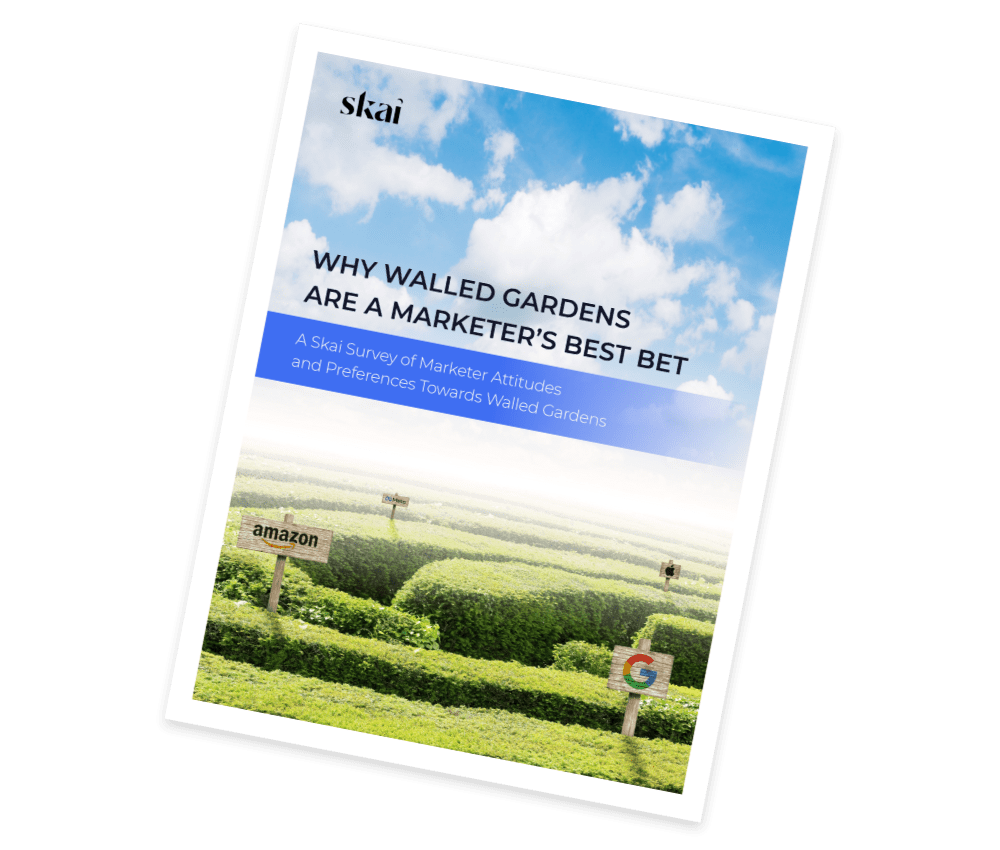
Joshua Dreller
Sr. Director, Content Marketing @ Skai

Joshua Dreller
Sr. Director, Content Marketing @ Skai

With the rise of digital advertising, marketers have had to figure out how to maximize their reach and return on investment in an increasingly fragmented market. One way to do this is through walled garden advertising, which can come with significant challenges.
In this article, we’ll be taking a look at these walled garden challenges and how best to approach them.

In digital advertising, a walled garden refers to a giant publisher operating in a closed ecosystem in which it controls all of its activity and processes. Good examples of these include Google Ads, Meta Ads, Amazon Ads, etc.
According to eMarketer, around 80% of U.S. digital advertising dollars is spent with walled garden publishers. While each walled garden is very different from the other, generally, we see three core characteristics that enable their many benefits:
Massive user bases. Some walled garden publishers have millions or billions of monthly average users. Even comparatively smaller walled garden publishers have a sizable monthly user base, like Snapchat (530+ million) and TikTok (1.8 billion).
Logged-in users across devices. Tracking users online fuels many advanced marketing tactics: personalization, ad targeting, measurement, and optimization. With new limitations on consumer data tracking, walled garden publishers can enable these critical use cases as they track their logged-in users behind the walls.
Engaging native ad formats. While the open web offers a tremendous scale of ad inventory, the creative options are minimal. However, because walled gardens have complete control over ad placements, they can provide innovative formats that take full advantage of the online environment and tend to work much better than basic ads.
Even though advertising through the walled gardens provides tremendous benefits, there are still some hurdles that marketers must overcome.
The walls of the walled gardens are a challenge for data exchange, as they protect users and their data from potential harm. The average consumer concerned about being tracked may need to realize that marketers cannot directly target them. Instead, advertisers set rules for their campaigns that the publishers fulfill for them anonymously.

A consistent criticism that marketers have had of the walled gardens for years is getting data in and out. Marketers need to get critical insights out and get data in to power their campaigns more effectively.
Getting data out. Walled gardens have treasure troves of data that marketers would love to have. These platforms have a wealth of information about what is taking place on retailer digital shelves, insights into which brands are winning ad auctions, and the market share of individual keywords and products.
While advertisers have managed to gain some access to this data over time, they only have access to a limited portion of it. The primary issue is that these proprietary datasets give the publishers a unique advantage, making them desirable brand partners. As a result, publishers are not motivated to fully share their data with marketers.
Getting data in. The same walls protecting user privacy from getting out also limit how brands can get data in. While there are some ways walled gardens have enabled marketers to use their zero and first-party data, these tactics fall a bit short of how advertisers would truly bring their proprietary data to bear if given the opportunity. With the new limitations on consumer data tracking, marketers are prioritizing their data assets to ready themselves for the data-less future; they need their walled garden partners to open up new lanes to leverage these datasets and not let their own walls get in the way.
“The next phase is getting a signal into the walled gardens because that’s where we don’t have the visibility,”
-Marc Pritchard, Chief Brand Officer, Proctor & Gamble.
Walled gardens are closed ecosystems, so each publisher can track every ad exposure to actions within its walls even if a user accesses the publishers differently — devices, browsers, etc. Additionally, by tagging a website with the walled garden’s tracking code, the publisher can connect those ad exposures to actions on a brand’s website to drive performance optimization. This is very much a closed-loop measurement approach, which works well.
However, most brands’ conversions consist of numerous ad exposures across publishers — sometimes scores of them. Thus, ultimately, walled gardens make gaining a holistic view of how customers have interacted with campaigns across multiple platforms much more difficult.
These walls also limit advertisers as they work across different walled gardens. For example, setting frequency caps for ad exposure is quickly done within a single-walled garden, but executing the same across multiple-walled gardens becomes extremely difficult, if possible. As a result, if a marketer were to set a frequency limit of four exposures across 10 walled gardens, they might end up showing 40 ads to the same person.

One of the great things about walled gardens is that there’s a very low barrier to entry. Most have free, easily accessible, and intuitive ad systems where anyone can create an account with a credit card. So, while your brand can take advantage of the benefits of working with walled garden advertising, so can your rivals.
For example, with Google Ads, your competitors can bid on your brand’s keywords, such as your company name, product names, etc. When consumers search on Google for your company, they may see ads from other companies triggered by your brand name. This is where a savvy rival can swoop in and steal customers.
And because walled gardens have garnered so much marketer attention, the reality is that walled garden ad costs continue to rise. Most of these are auction-based channels, so the market sets the prices — with more competition, the prices go up. Marketers who plan to continue leveraging walled gardens as the majority of their budgets must find ways to keep costs low in order to remain efficient.
Each walled garden publisher has its own ad system with its own nuances, meaning you have to learn each platform separately. You can do some things with certain publishers that you can’t do with others. There are even different names for the same things. For example, metric ad impressions may be called imps, served impressions, or other terms.
Because they don’t integrate with each other, even simple tasks take more time than they should. If you wanted, for example, to pause a campaign, you have to go into each and every publisher’s backend system and do that separately.

At any given moment, your boss, stakeholders, or clients may ask you to report on critical metrics and other information from your marketing. A typical example of this is pulling spend. A client may want to know exactly how much of the media budget has been spent that quarter. If you’re working with 10 walled garden publishers, you would have to go into the ad systems of each publisher, run reports for the date range requested, import the data into a spreadsheet, and then add everything together.
While this isn’t an arduous task, it can be time-consuming. Then what if, the very next day, they want to know how many clicks they received yesterday? You would have to go through the same process again.
And although adding more time to a marketer’s day may be a slight annoyance, the real-world net effect of this issue is that teams will be less apt to act if they have a hunch. They may not have the time to pull and aggregate these reports on a gut feeling — but we all know that these moments of inspiration are when groundbreaking ideas are formed.
The fact that 80% of digital advertising is spent on walled gardens is enough evidence to show that marketers find value in them.

How do marketers take advantage of these great benefits while bypassing or reducing the challenges presented in this article?
The answer is technology. Specifically, marketers should consider third-party vendors that integrate with the walled garden publishers to offer functionality beyond the native platforms to deliver enhancements across the board.
When marketers were asked if they preferred the native platform plus third-party platforms versus the native platform alone, they affirmed the value of partner technology more than 2 to 1.
If you’re investing a significant portion of your budget into walled garden advertising, consider a third-party platform like Skai to help you accentuate the positives and reduce the negatives.
For more information about how Skai can help you connect the walls of the walled gardens, please reach out today and schedule a brief demo.
You are currently viewing a placeholder content from Instagram. To access the actual content, click the button below. Please note that doing so will share data with third-party providers.
More InformationYou are currently viewing a placeholder content from Wistia. To access the actual content, click the button below. Please note that doing so will share data with third-party providers.
More InformationYou are currently viewing a placeholder content from X. To access the actual content, click the button below. Please note that doing so will share data with third-party providers.
More Information